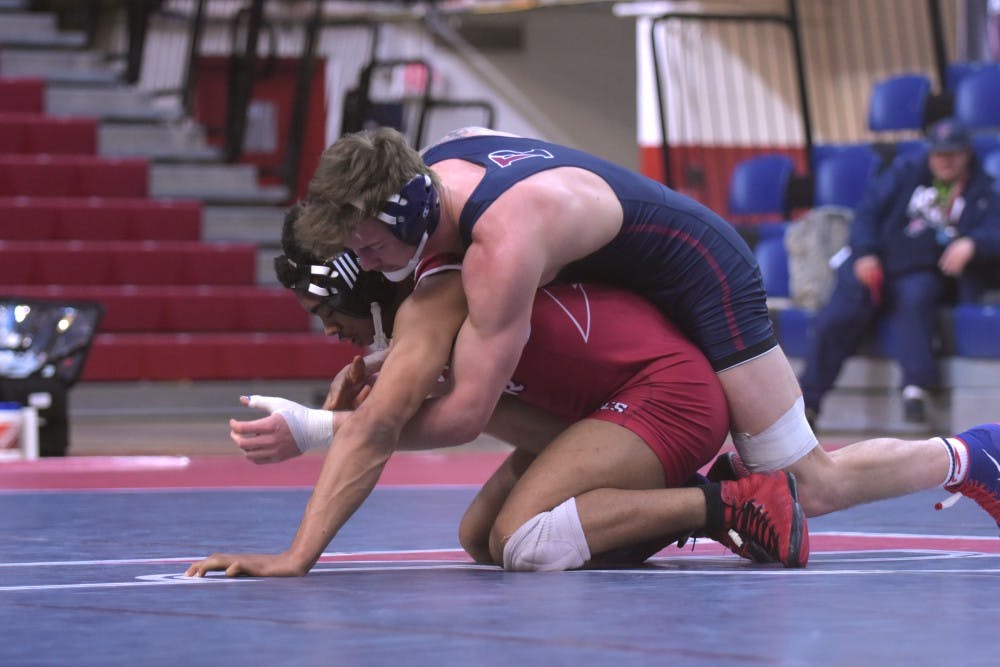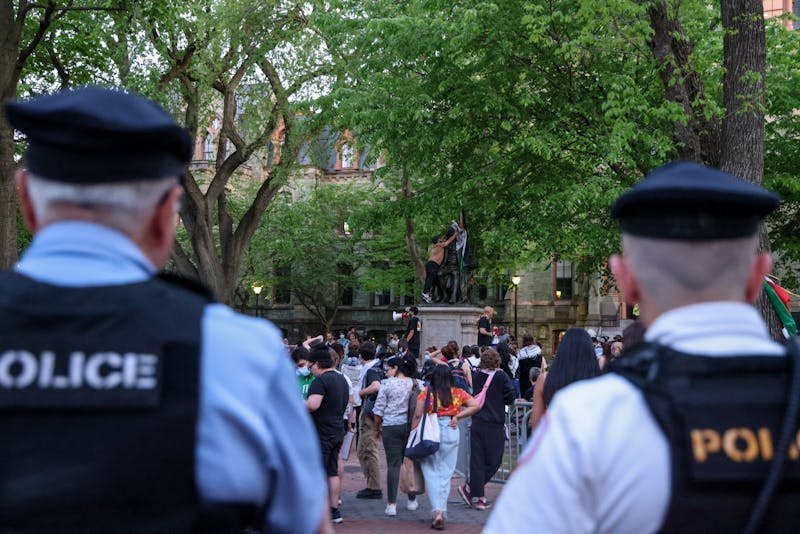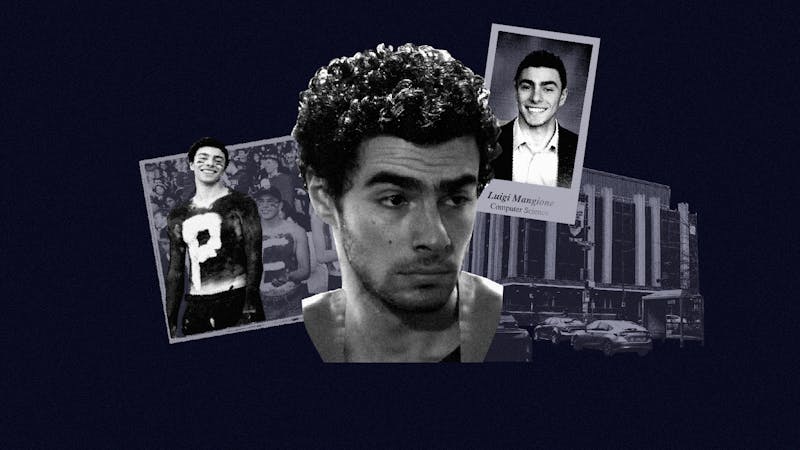
Senior 184-pounder Lorenzo Thomas leads the Quakers as they head to New York City for the NCAA Championships.
Credit: Guyrandy Jean-GIlles , Guyrandy Jean-GIllesThere was no grand re-debut for Casey Kent. There was no Palestra, no ovation, no spectacle. That never slowed down Kent before and it would not stop the Norristown, Pa., native at the Binghamton Open.
It was Kent’s first match in nearly two years. By the result, it would have seemed that Kent had not spent a minute away from the mat. He shut out Cornell’s Drew Garcia, 4-0, and took out Harvard’s NCAA championships-bound Josef Johnson and Lehigh’s Ben Haas in the tournament before eventually being eliminated in the semifinals in a tight contest against another national tournament-bound grappler in Jonathan Schleifer.
Perhaps the result was not everything he could have hoped for, but it was his official return to the mat after sitting out the entire 2014-2015 season. And it was just the start of what ended up being his best season to date: He finished fourth at 174 pounds in the NCAA Championships last week, becoming the 28th All-American in Penn history.
At Penn, Kent is one of the few wrestlers who took a year off from wrestling for the school and in turn gained another year of eligibility. At schools outside the Ancient Eight, however, this is common practice.
The Ivy League disadvantage
In collegiate wrestling, there exists a great disconnect between the NCAA and the Ivy League in their policies.
In all sports, the NCAA allows schools to take advantage of a practice called “redshirting.” In this process, schools sideline a player — often a freshman — for a majority of the season’s competition and keep them out of dual meets. In turn, players gain an extra year of NCAA eligibility while still being able to practice with their team.
Many of the nation’s top programs take full advantage of this program in order to give freshmen a year of training and an added year of eligibility instead of essentially losing their first year. Ivy League wrestling, however, bars this practice. Instead, athletes begin a four-year clock upon enrolling as freshmen that can only be paused under certain circumstances.
This would appear to be a huge disadvantage for Ivy League programs that wrestle against older and more experienced athletes from other programs outside of the Ancient Eight. However, it is unclear just how disadvantageous this is for Penn wrestling.
Second-year coach Alex Tirapelle, for example, said that outsiders may see lopsidedness more than he does.
“If you asked me coming into college, I would’ve said, ‘Yeah, 100 percent it’s an advantage’ but now having coached for a while I don’t think it necessarily is: at least for our sport, specifically for our sport,” he said.
“It’s whatever you want to make it.”
The wrestlers themselves are equally unsure of the advantages that schools with five-year tracks have over the Ivy League. Senior Lorenzo Thomas said that while the fifth year option is advantageous for the schools that can offer it, the advantage applies on a case-by-case basis.
“It can [be an advantage], but it’s up to the person. It’s whatever you want to make it,” Thomas said. “It’s an extra year to prepare but it’s not always essential.”
In contrast, senior Brooks Martino felt that Penn is not at an outright disadvantage, but is aware that other schools do have an advantage because of redshirting.
“I would say that it’s something that a lot of other schools do take advantage of and it works [in] their favor,” Martino said. “I wouldn’t say that it’s working against us, but it’s just that other schools are able to take advantage of it whereas we’re not.”
Tirapelle finds that those who take a year off from their team early in their collegiate career struggle to find success later on because of the toll that wrestling takes on the body.
“In their first years they’re like, ‘I wanna be the most competitive. I wanna be able to challenge to be a national champion my first year of wrestling.’ That’s great, but you gotta think of the back end as well,” Tirapelle said. “There’s a big difference between wrestling for four years and wrestling for five years. That’s an additional year of bang and mileage on the body, which a lot of the time catches up to you on the back end, unfortunately.”
Quinton Hiles, a Penn wrestler in the middle of a year off who plans to return to wrestling at the school next fall, said that while the Ivy League’s rules can be a disadvantage, going to a school in the Ivy League affords him other opportunities.
“It does [give other schools the advantage], but I guess it’s a part of the Ivy League culture. We choose to go here, not just for athletic reasons, so we kind of have that balance,” Hiles said. “So it’s a small disadvantage but I mean when you’re allowed to take an extra year and spend it a different way it kind of balances out.”
Hiles added that, while redshirting is not allowed, Ivy League wrestlers do have the opportunity to extend their eligibility by another year.
Under certain, abnormal circumstance, wrestlers can take a year off from school for personal, academic, or financial reasons and in turn gain a fifth year of eligibility in collegiate wrestling. Right now, there are a total of six wrestlers who are wrestling or will be wrestling for Penn next year who have taken a season off from the sport or have withdrawn from the school.
Lorenzo Thomas
The first member of the current roster to step back from Penn for a year is Lorenzo Thomas. The only 100-win 184-pound wrestler in program history, Thomas started wrestling for Penn in 2011-12 and immediately made waves by earning a unanimous first team all-Ivy selection.
After that season, Thomas made the decision to withdraw from Penn for a year for “financial and personal reasons.” As part of this, Thomas returned to his high school, Pittsburgh Central Catholic, where he attended practice. He traveled to tournaments without affiliation and remembers his father being in his corner for matches.
While home, he was still able to communicate with the coaches, which he thought was “definitely” helpful.
In Fall 2013, Thomas returned to school as a sophomore. Re-entering a cutthroat academic environment like Penn after a year off, Thomas said, is a serious endeavor.
“It was difficult to get back used to school. It was a tough semester for me,” he said. “Wrestling-wise it was a little different (because I was on my own) and coming back to the team was a little different, but after a little bit it wasn’t too bad a transition.”
After his return, Thomas had his best season to date, jumping two weight classes and finishing with a 30-7 record, an NCAA Championship berth and All-American accolades. For Thomas, taking a year off helped him to further succeed in his collegiate wrestling career.
“I think I matured a lot in that year I took off. Especially since it was my second year that I took off, I was able to reflect on my first year and see what I needed to change in order to achieve the goals I wanted to achieve.”
Brooks Martino
The 2013-14 season did not go without a hitch for all of Penn wrestling. In wrestle-offs in November, Brooks Martino tore his ACL, erasing any chance he had of wrestling his sophomore year.
As a result, he was granted a fifth year of eligibility for medical hardship. That development meant that he could undergo treatment for the ligament tear without losing out on a year of competition.
The next few months were slow for Martino, who placed a heavy emphasis on weightlifting as a way to stay in shape while also going through the daily grind of schoolwork. Instead of being a year off school, Martino said that 2013-14 was a “year off from wrestling.”
It was not until mid-summer that Martino was able to return to the mat. Because his year away from wrestling prevented him from practicing in any form, it is difficult for Martino to say that this year truly helped his development as a wrestler.
“I haven’t really reflected on that since my career is not over. I did have my most successful year after my injury so you could argue that taking off to lift and refocus and observe the sport from an outside perspective did help me,” he said. “But at the same time everyone else was wrestling and getting better and improving their technique. So I don’t know, I can’t really answer that question.”
Thomas and Martino took years off from school and from wrestling, respectively, but one thing they do have in common is that both of them had their best seasons after, as they both described, taking time to reflect on their career.
Frank Mattiace
The next season, 2014-15, saw the arrival of coach Alex Tirapelle from Stanford, a program that heavily utilizes redshirting to delay eligibility for its wrestlers.
Before ever being able to see his team wrestle in person, Tirapelle had learned that sophomore Frank Mattiace and junior Casey Kent would not be wrestling for the team that season, with the former withdrawing from the school and the latter receiving his medical hardship.
Mattiace’s decision to take a year off came down to “personal reasons” but did take place right after a 2014 season that saw him place eighth in the Eastern Intercollegiate Wrestling Association while wrestling to a 16-16 record.
Unlike Thomas’ year off, where the Pittsburgh, Pa., native returned to his high school to train, Mattiace was able to stay in the Philadelphia area. Better yet, he even wrestled on Penn’s campus, thanks to the Regional Training Center, a wrestling program that trains athletes in the Olympic styles of wrestling, freestyle and Greco-Roman, as opposed to traditional collegiate wrestling. The RTC helped Mattiace to keep in touch with his coaches while also building his work ethic.
“It was really nice. It definitely helped me keep my competitive edge and level to where it needed to be to coming back to the school and [gave] me opportunities to go to the Olympic training center as well as [to] compete through other tournaments,” Mattiace said.
Mattiace saw this year away from Penn and organized collegiate wrestling as helpful in his mental, rather than physical, approach to the sport.
“From a sense of not being on the team it’s a little different. It’s not the most ideal situation but its really nice too because it holds yourself accountable and when you’re put in that situation it kind of makes you do things right for yourself and you do it for yourself and not because your coach told you to,” he said. “It helps you [on a] personal level. It helps you make some strides.”
For Mattiace, the transition back to wrestling was more seamless than Martino’s. As Mattiace recognizes, being in the city allowed him to stay in a competitive atmosphere, which helped him feel like a part of the team. Moreover, Mattiace took summer courses and was able to wrestle with the team again before the following season.
Casey Kent
For entirely different reasons, Kent also did not compete for the Quakers in the 2014-15 season, and was also granted fifth-year eligibility.
Casey Kent arrived at Penn in fall 2012 as a freshman and immediately started for the team at the 165-pound weight class. After a promising freshman and sophomore season, the latter of which ended with a bid to the NCAA Championships, the future looked bright for the Norristown, Pa., native.
However, heading into his junior year, Kent noticed a pain in his back that he couldn’t shake off.
“It was bothering me [during the 2013-14 season] and then the beginning of the next year so I went to the doctor’s and there was stuff wrong with my back,” Kent said. “It was really bothering me to wrestle.”
Kent’s back injury kept him off the mat the entire season and into that summer. Finally he returned to weight lifting and his training regimen. Going into the season, Kent noticed that the positioning and form came back naturally, but that “it was like taking a long break” that required getting back in shape.
Decisions that aren’t made lightly
In the 2015-16 season, sophomores Dan McDevitt and Quinton Hiles both withdrew from Penn for personal reasons. They train together at the RTC and wrestle near the same weight class which gives them plenty of practice repetitions together. For them, they both worked their way to a decision with help from Tirapelle.
“These aren’t decisions that are entered into lightly. They look at the grand scheme of things, ‘What’s best for me at this moment of my life,’” Tirapelle said. “For [McDevitt], he had some circumstances that when we sat down and really looked at it we said, ‘Hey this is probably what’s best moving forward.’”
Because of their timing, McDevitt and Hiles have the benefit of being able to talk to Mattiace who went through the same exact process in 2014-2015. That has made a world of a difference for the two soon-to-be juniors.
“Absolutely [he has helped me]. Watching him last year opened my eyes that a year off from school does not equate to a year off from work necessarily,” McDevitt said, noting that he works 30 hours weekly, which essentially substitutes going to class.
Next year, McDevitt and Hiles will be competing for their spots in the starting lineup. Before that, the two will need to work to get back to the competition level that the rest of the team currently shares. Tirapelle says that this is a testament to the challenges that come with taking a fifth year.
“But there’s no easy way to do it, if you’re not in it day-in and day-out, really living it, it will be challenging to get back in,” Tirapelle said. “There [are] advantages and disadvantages. I’d say slight disadvantages from jumping back in. It takes some time to get back into it.”
The Daily Pennsylvanian is an independent, student-run newspaper. Please consider making a donation to support the coverage that shapes the University. Your generosity ensures a future of strong journalism at Penn.
DonatePlease note All comments are eligible for publication in The Daily Pennsylvanian.







